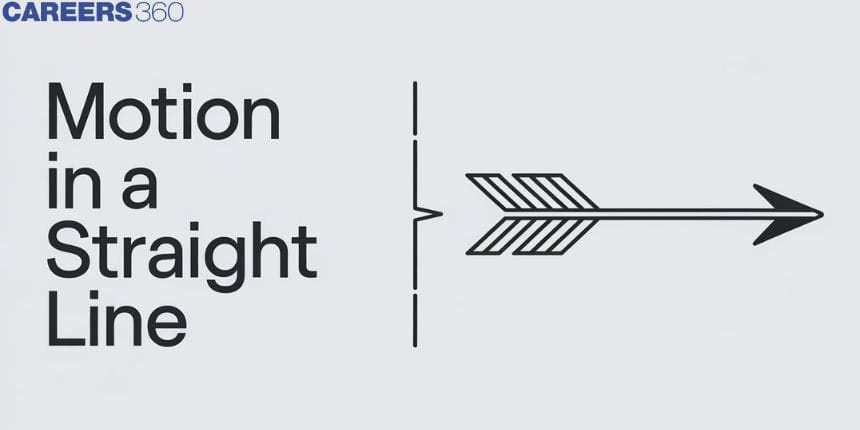Motion In A Straight Line - Definition, Formulas, Examples, FAQs
In straight motion, an object’s position continuously changes with time and goes in a linear direction relative to a fixed point. The analysis of this type of motion is done using linear kinematics and therefore forces us to introduce concepts such as displacement, velocity, and acceleration, which are all essential in the branch of physics known as kinematics.
JEE Main/NEET 2027: Physics Important Formulas for Class 10
NEET 2025: Mock Test Series | Syllabus | High Scoring Topics | PYQs
JEE Main: Study Materials | High Scoring Topics | Preparation Guide
JEE Main: Syllabus | Sample Papers | Mock Tests | PYQs

What is Motion?
Before we begin Motion in a Straight Line motion, let's first introduce 'what is motion'?. In our daily life, we are surrounded by moving objects. For example: Walking on the streets, a running boy, etc. The above movements of the objects are examples of motion.
Motion: The change in the position of any object with respect to time is called motion.
Kinematics: The study of the motion of an object without knowing its cause is called kinematics.
Also read :
- NCERT Notes For All Subjects
- NCERT Solutions for All Subjects
- NCERT Exemplar Solutions for All Subjects
What is Straight-Line Motion?
Movement is a phenomenon in which an object over time changes position. In terms of movement, distance, speed, acceleration along with time, motion is described quantitatively. In the field of physics that describes the motion of objects but does not refer to the source of objects is called kinematics.
Motion in Straight Line Formulas
Three motions in straight-line formulas are as follows:
1.
2.
3.
Define Linear Motion
Linear motion is the motion that is natural to an object: moving in a straight line. According to Newton's First Law of Motion, an object not affected by any force will continue indefinitely in a straight line. The position x, which varies with t, can be used to explain the motion of a particle (a point-like object) down a line (time). An athlete running 100 metres on a straight track is an example of linear motion. Motion along a straight line is called linear motion.
|
Related Topics |
Types of Linear Motion
Linear motion, also called Rectilinear Motion can be of two types:
1. Uniform linear motion with constant velocity or zero acceleration
2. Non-uniform linear motion with variable velocity or non-zero acceleration
Movement in a straight line is literally one-dimensional and is simplest. Based on the first law of Newton, this says that an object will remain at rest or continue in straight motion at a uniform speed until an external force does not act upon it.
Do not confuse linear motion with general motion, because as we've mentioned, linear motion is one-dimensional. But in general, it has both a magnitude and direction, such that we describe an object's position and velocity in vector quantities.
Uniform Motion in a Straight Line
if a body moves along a straight path and at regular intervals of time it travels equal distances, it is said to have uniform motion. Simply put, uniform acceleration in the body means that the rate of change of velocity is constant.
Example:
If a car travels at a speed of
Non-uniform Motion in a Straight Line
In contrast to uniform acceleration, a body is said to exhibit non-uniform motion when it has unequal changes in velocity over equal intervals of time - that is, the rate of change of velocity differs at different time points during its motion.
Example:
A boy is kicking a football. It might cover 4 meters in the first attempt, 6 meters in the second change, 9 meters in the third attempt and so on as per the velocity exerted by the boy.
Frequently Asked Questions (FAQs)
Linear motion is a one-dimensional motion along a straight line. When an object travels in a straight line, its position changes with the passage of time. A stone falling from a set height, an athlete running 200 metres on a straight track, a train travelling on a straight track, along with an automobile going at a consistent speed are all examples of linear motion.
The movement of any object from one position to another position with respect to the observer is called Motion and when an object moves along a straight line, the motion of the object is called rectilinear motion.
Positive acceleration occurs when an object's speed rises over time. Acceleration is measured in the direction of motion, and it is negative if the speed of an item decreases over time. The direction of motion is reversed with acceleration.
A particle is considered to be travelling in one dimension if it moves in only one direction throughout its journey.
Also Read
22 Jun'25 04:12 PM
05 Feb'25 04:57 PM
11 Jan'25 03:00 PM
24 Dec'24 01:28 PM
27 Nov'24 01:02 PM
26 Nov'24 01:31 PM
20 Nov'24 04:50 PM
20 Nov'24 12:59 PM
16 Nov'24 01:06 PM
14 Nov'24 04:17 PM

